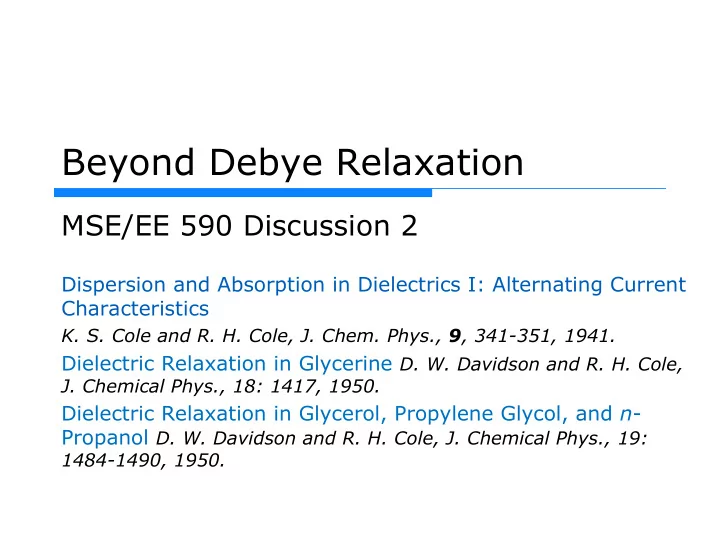

Beyond Debye Relaxation MSE/EE 590 Discussion 2 Dispersion and Absorption in Dielectrics I: Alternating Current Characteristics K. S. Cole and R. H. Cole, J. Chem. Phys., 9 , 341-351, 1941. Dielectric Relaxation in Glycerine D. W. Davidson and R. H. Cole, J. Chemical Phys., 18: 1417, 1950. Dielectric Relaxation in Glycerol, Propylene Glycol, and n - Propanol D. W. Davidson and R. H. Cole, J. Chemical Phys., 19: 1484-1490, 1950.
Kramer ’ s-Kronig relations These relations stem from the basic principle of o causality, that “ the polarization response of matter to an electric excitation cannot precede the cause ” . D (t) = E (t) + ∫ 0 ∞ f( τ ) E (t- τ )d τ n f( τ ) is a function of time and properties of the n medium, is finite, and is only significantly different from 0 for a period of time similar to the relaxation time Assume ω is a complex variable and use math to show o that ε ( ω ) is regular in the upper half plane – a direct consequence of causality The Kramer ’ s-Kronig relations follow o See secs. 77 and 82 of Landau & Lifshitz ’ “ Electrodynamics of Continuous Media ” 362-08-Lecture 20 2
Hydrogen bonding A hydrogen bond is the attractive interaction of a o hydrogen atom with an electronegative atom, such as nitrogen, oxygen or fluorine, that comes from another molecule or chemical group. The hydrogen must be covalently bonded to another o electronegative atom to create the bond. These bonds can occur between molecules o ( intermolecularly ), or within different parts of a single molecule ( intramolecularly ). The hydrogen bond (5 to 30 kJ/mole) is stronger than a o van der Waals interaction, but weaker than covalent or ionic bonds. This type of bond occurs in both inorganic molecules such as water and organic molecules such as DNA. 362-08-Lecture 20 3
Hydrogen bonding An example of intermolecular hydrogen bonding in a self-assembled dimer complex Beijer et al, Angew. Chem. Int. Ed. 37 (1– 2): 75–78, 1998. 362-08-Lecture 20 4
Havriliak-Negami Model MSE/EE 590 Discussion 5 A Complex Plane Analysis of α -Dispersions in Some Polymer Systems S. Havriliak and S. Negami, J. Polym. Sci. C, vol. 14, pp. 99-117, 1966.
95%PMMA-5%MMT, T = 50 °C ! 362-08-Lecture 20 6
95%PMMA-5%MMT, T = 100 °C ! 362-08-Lecture 20 7
Relaxation ‘map’ or Arrhenius diagram T g PMMA, b 6 PMMA, a 5MMT, b 5 5MMT, a 5MMT, MWS 4 10MMT, b 10MMT, a 3 10MMT, MWS 2 1 0 log [frequency (Hz)] -1 -2 2.2 2.4 2.6 2.8 3.0 3.2 3.4 -1 ) 1000/T (K 362-08-Lecture 20 8
Temperature dependencies o Vogel-Fulcher-Tamman-Hesse eqn. # % ( ) f = f 0 exp B / T ! " T $ & n T’ usually 30 to 70 degrees < T g o Arrhenius Law " $ ( ) f = f 0 exp ! E a / RT # % n E a is the activation energy for the process 362-08-Lecture 20 9
Molecular Dynamics from Temperature-Dependent Dielectric Spectroscopy MSE/EE 590 Discussion 6 Influence of Cooperative α Dynamics on Local β Relaxation during the Development of the Dynamic Glass Transition in Poly( n -alkyl methacrylate)s F. Garwe et al, Macromolecules, vol. 29, 247-253, 1996.
Alkyl groups o An alkyl group, generally abbreviated with the symbol R, is a functional group or side-chain that, like an alkane, consists solely of single-bonded carbon and hydrogen atoms, for example a methyl or ethyl group. 362-08-Lecture 20 11
Tacticity Tacticity is the relative stereochemistry of adjacent chiral o centers within a macromolecule and affects the physical properties of the polymer. The regularity of the macromolecular structure influences the degree to which it has rigid, crystalline long range order or flexible, amorphous long range disorder. Tacticity affects at what temperature a polymer melts, how soluble it is in a solvent and its mechanical properties. Isotactic polypropylene Syndiotactic polypropylene 362-08-Lecture 20 12
Fitting functions o One or a sum of N HN functions is used to fit experimental ε ’’ ( ω ): ⎧ ⎫ N Δ ε ⎪ ⎪ ( ) Im n ∑ ʹ″ ʹ″ ε ω = ⎨ ⎬ [ ] ⎪ β 1 ( ) − α 1 i n ⎪ + ωτ n 1 = ⎩ ⎭ 0 n o A conductivity contribution is included ⎧ ⎫ N Δ ε ⎪ ⎪ c ( ) A Im n − ∑ ʹ″ ʹ″ ε ω = ω + ⎨ ⎬ [ ] ⎪ β 1 ( ) − α 1 i n ⎪ + ωτ n 1 = ⎩ ⎭ 0 n 362-08-Lecture 20 13
PnBMA: ε ’’ v. log ω for various T 362-08-Lecture 20 14
PnBMA: Relaxation map 362-08-Lecture 20 15
Mechanical and Dielectric Relaxations in Polymers MSE/EE 590 Discussion 7 Comparative Study of Mechanical and Dielectric Relaxations in Polymers R. Díaz-Calleja and E. Riande, Materials Science and Engng. A, vol. 370, 21-33, 2004.
Ref: Thermal Analysis of Polymers, Menczel & Prime, 2009 ε ’’( ω ), constant T 362-08-Lecture 20 17
Ref: Thermal Analysis of Polymers, Menczel & Prime, 2009 ε ’’(T), constant ω 362-08-Lecture 20 18
Ref: Thermal Analysis of Polymers, Menczel & Prime, 2009 Arrhenius diagram for mechanisms commonly observed in polymers 362-08-Lecture 20 19
Type A chains Polymer dipoles are classified as A, B or C. Type A dipoles are rigidly fixed to the chain backbone so that their reorientation requires motion of the molecular skeleton, and are parallel to the chain contour. 362-08-Lecture 20 20
Recommend
More recommend